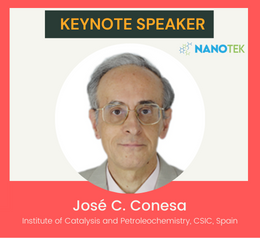Scholars Frontiers in
Nanoscience and Nanotechnology Congress
THEME: "Fostering Advancements in Nanoscience and Nanotechnology"
 27-28 Mar 2023
27-28 Mar 2023  Crowne Plaza Ealing, London, UK & Online
Crowne Plaza Ealing, London, UK & Online THEME: "Fostering Advancements in Nanoscience and Nanotechnology"
 27-28 Mar 2023
27-28 Mar 2023  Crowne Plaza Ealing, London, UK & Online
Crowne Plaza Ealing, London, UK & Online 
Institute of Catalysis and Petroleochemistry, CSIC, Spain
Title: Computing with hybrid DFT methods interfaces between semiconductors
J.C. Conesa entered the ICP staff in 1979; he was ICP Vicedirector, then ICP Director, being now ICP Ad Honorem Professor. He was first in Spain using SR techniques to study heterogeneous catalysis, and first in CSIC to use quantum calculations to understand them. He is expert in XPS and FTIR (including operando), EPR, UV-Vis-NIR. He has analyzed CeO2-supported metals and oxides, more recently for H2 production. He has kept furthermore continued interest in photocatalysis and photoactive solids. He belongs to the Steering Committee of AMPEA, a JP of the European EERA devoted to sustainable energy. His over 210 articles and book chapters have received more than 10100 citations, leading to a Hirsch index h=58.
Band offsets between semiconductors are crucial to determine the direction of electron transfer at their interfaces, which is important in particular for photocatalysis and photoelectrochemistry. Two methods are normally used to compute such offsets from first principles: alternating slabs put in contact, without empty spaces between them, and separate calculations of each material surface confronted with empty vacuum space. The first method has the risk of introducing distortions due to insufficient epitaxial match, which may lead to bandgap changes, and the second may neglect electron transfer at the interface, which may be important in systems having very different average electronegativities, and also implies a spill of electronic density into the vacuum space which will not be present in the real interfaces. In this work results will be compared using both approaches for different interfaces: anatase TiO2/ZnO (relevant for photocatalysis), and also a comparison of interfaces between CuGaS2 and either ZnS or CdS, possibly relevant for photovoltaic materials, will show the effects of significant epitaxial mismatch. The same comparison will also be made in the PbTe|TiO2 (rutile) and diamond|grey tin, and finally the system BiVO4/NiOOH (relevant for photoelectrochemistry) will be studied. The method will be based on using for the bulk phases hybrid DFT methods providing bandgap values coincident with the experimental ones, and transferring subsequently to the interfaces the distances between the band positions and the profile of the electrostatic potential as previously suggested (C. G. Van de Walle & R. M. Martin, Phys. Rev. B 1987, 35, 8154). In all cases it will be ensured that all interfaces are nonpolar according to Tasker’s criterium (P.W. Tasker, J. Phys. C: Solid State Phys. 1979, 12, 4977). A critical analysis of any relevant differences found will be presented.